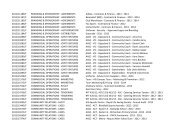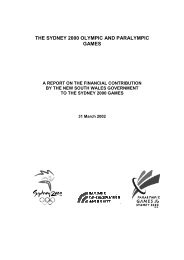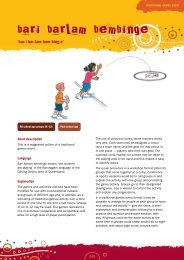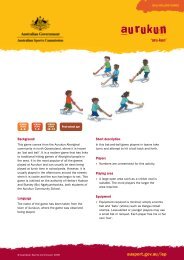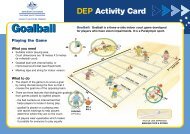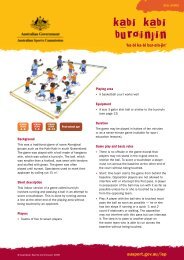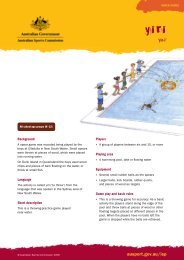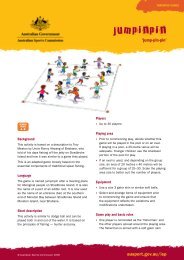Current Concepts in Sports Nutrition - Australian Sports Commission
Current Concepts in Sports Nutrition - Australian Sports Commission
Current Concepts in Sports Nutrition - Australian Sports Commission
You also want an ePaper? Increase the reach of your titles
YUMPU automatically turns print PDFs into web optimized ePapers that Google loves.
Dur<strong>in</strong>g Exercise / 26<br />
When sweat losses are high (>800ml) it becomes difficult to consume fluid at<br />
rates that fully replace these losses. In some situations, it is not practical to match<br />
sweat rates, as the nature of the sport means that the effort to dr<strong>in</strong>k causes more<br />
disadvantage than the benefits ga<strong>in</strong>ed from reduc<strong>in</strong>g the fluid deficit. Fluid <strong>in</strong>take<br />
needs to be a trade-off between how much fluid can be managed and tolerated and<br />
the potential benefit to performance. Gastric empty<strong>in</strong>g rates, <strong>in</strong>dividual tolerance<br />
and dr<strong>in</strong>k<strong>in</strong>g opportunities all <strong>in</strong>fluence the amount of fluid that can be consumed<br />
comfortably dur<strong>in</strong>g exercise. Fluid <strong>in</strong>take dur<strong>in</strong>g exercise is likely to be better tolerated<br />
when small amounts are consumed at frequent <strong>in</strong>tervals rather than try<strong>in</strong>g to guzzle<br />
larger amounts on a few occasions.<br />
Excessive dr<strong>in</strong>k<strong>in</strong>g can cause a life-threaten<strong>in</strong>g condition called hyponatraemia. This<br />
occurs when there is a dilution of the normal concentration of sodium <strong>in</strong> the blood,<br />
and is associated with symptoms such as confusion, headaches, fatigue and coma.<br />
Hyponatraemia is not common but can occur <strong>in</strong> prolonged (>2–3 hours) endurance<br />
events such as marathons and Ironman-distance triathlons when <strong>in</strong>dividuals dr<strong>in</strong>k <strong>in</strong><br />
excess of their rates of sweat loss.<br />
Those most at risk of hyponatraemia are small athletes with low rates of sweat loss<br />
(that is, low-moderate exercise <strong>in</strong>tensity) who consume large amounts of sodium-free<br />
fluids. S<strong>in</strong>ce there is no benefit to overhydrat<strong>in</strong>g dur<strong>in</strong>g an event, athletes are now<br />
warned aga<strong>in</strong>st dr<strong>in</strong>k<strong>in</strong>g fluid at rates <strong>in</strong> excess of their sweat losses. This provides<br />
an additional reason for the athlete to monitor their unique rates of sweat loss over a<br />
range of their sport<strong>in</strong>g activities and develop fluid <strong>in</strong>take plans accord<strong>in</strong>gly.<br />
Fluid balance and sweat loss calculations<br />
Step 1: Change <strong>in</strong> body mass - Measure body mass before exercise <strong>in</strong> m<strong>in</strong>imum cloth<strong>in</strong>g (eg 60kg) and<br />
immediately after exercise <strong>in</strong> same cloth<strong>in</strong>g towel dried (eg 58kg).<br />
Step 2: Fluid <strong>in</strong>take - Measure mass or volume of dr<strong>in</strong>k bottle/s before exercise (eg 800ml) and immediately<br />
after exercise (eg 300ml).<br />
Step 3: Ur<strong>in</strong>e or toilet losses - Measure difference <strong>in</strong> mass before and after go<strong>in</strong>g to the toilet.<br />
Calculations:<br />
1. Fluid deficit(ml) = Change <strong>in</strong> body mass from before to after exercise x 1000 (eg 60kg-58kg=2kg<br />
x 1000 = 2000ml<br />
2. Fluid <strong>in</strong>take(ml) = Change <strong>in</strong> mass of fluid bottle from before to after exercise (eg 800ml-300ml=500ml)<br />
3. Ur<strong>in</strong>e losses(ml) = Change <strong>in</strong> body mass before and after toilet<strong>in</strong>g x 1000 (eg 59kg-58kg=1kgx1000=1000ml)<br />
4. Total sweat loss = Fluid deficit (ml) + Fluid <strong>in</strong>take (ml) - ur<strong>in</strong>e losses (ml) (eg 2000ml+500ml-1000ml=<br />
1500ml sweat loss).<br />
5. Hourly sweat rate = Simply divide total sweat loss dur<strong>in</strong>g exercise by the duration of the exercise.<br />
6. % dehydration = Total fluid deficit (kg) divided by pre-exercise mass (kg) x 100 (eg 2/60x100=3.3%).<br />
Any weight loss reflects a mismatch between fluid <strong>in</strong>take and fluid loss dur<strong>in</strong>g exercise. A deficit of one<br />
kilogram <strong>in</strong>dicates that you have failed to replace approximately one litre of fluid dur<strong>in</strong>g exercise.




